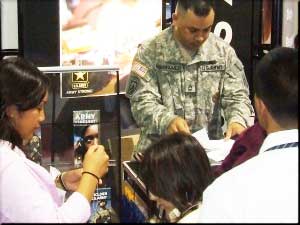From Draft NOtices, October—December 2008
— Jorge Mariscal
 Strolling across the convention center with her granddaughter, Dolores Huerta, whomade history with Cesar Chavez more than 40 years ago, received an occasional greeting from those who recognized her. But most of the well-dressed Latino and Latina 20- and 30-somethings hurried past her on their way to free salsa lessons sponsored by Ford or free beer provided by Miller Lite.
Strolling across the convention center with her granddaughter, Dolores Huerta, whomade history with Cesar Chavez more than 40 years ago, received an occasional greeting from those who recognized her. But most of the well-dressed Latino and Latina 20- and 30-somethings hurried past her on their way to free salsa lessons sponsored by Ford or free beer provided by Miller Lite.
Like the dozens of recently arrived immigrants and long-time permanent residents on their way to the free workshops on citizenship, they had no idea that they had just rubbed elbows with one of the major figures of U.S. labor and civil rights history.
If Barack Obama symbolizes “post-civil rights” politics, the National Council of La Raza (NCLR) conference held in San Diego in mid-July embodied a post-Chicano Movement universe in which unions, mass mobilizations, and social critique are relics of a long-gone era.
The NCLR Expo was a corporate-funded orgy of mainstream Hispanic identity and culture. Outside the convention center, misguided Minutemen and others angry about the immigration mess clung to the deluded belief that NCLR was a “leftist” or “separatist” organization. Inside the building, representatives of every branch of the military, the CIA, and the Department of Homeland Security belied the right-wing paranoia.
There are virtually no remaining links to the Chicano and Puerto Rican militancy of the Vietnam War era that typified NCLR’s founding fathers — Herman Gallegos, Ernesto Galarza, and Julian Samora. The NCLR today is the brainchild of former director Raul Yzaguirre and the top-down corporate vision he imposed on the organization in the late 1970s. Part of that vision was for NCLR to work closely with the Pentagon in order to tailor its recruiting sales pitch to Latino youth.
On the floor of the convention center, those with the flashiest displays received the greatest attention. Dozens of Latino and Latina youth crowded around the U.S. Army booth where soldiers clad in fatigues printed out personalized dog tags in exchange for the young person’s contact information. Army personnel roamed the aisles of the Expo engaging young people in conversation.
Across from the Army display, young Latino Marines in dress blues invited children from 8 to 18 to do pull-ups on two improvised bars. An attractive young Latina Marine barked “Aguanta, aguanta” as she encouraged a young girl to do one more pull-up. A tall NCO handed out tiny Marine backpacks to eager middle school children.
At the far end of the hall were the booths for those minimally funded volunteer organizations like Project YANO that quietly do their work day after day in real communities. Noticeably absent were displays devoted to education. Book vendors were difficult to find and only one or two colleges were represented.
An enterprising group of college students with a sense that the military was preying on its sisters and brothers gathered brochures from a health organization dedicated to issues of spinal trauma. Positioning themselves near the Army and Marine displays, they distributed the brochure “Paralysis and Brain Injury in Active Duty Military” to each young person with a dog tag or a backpack. The students were quickly dispersed by convention center security.
Dolores Huerta stopped by to congratulate Project YANO for providing Latino youth with the facts about military service then hurried off to a meeting with Obama campaign organizers. Her place in the progressive history of Latinos in the United States is fixed. Future generations will have to judge whether NCLR’s contributions were for the benefit of the entire Latino community or not.
This article is from Draft NOtices, the newsletter of the Committee Opposed to Militarism and the Draft (http://www.comdsd.org)





